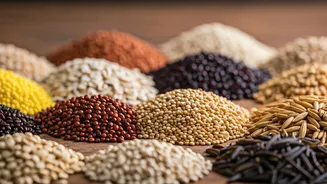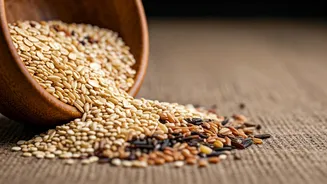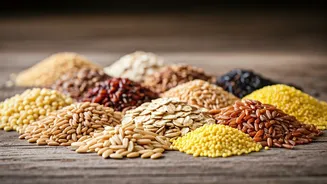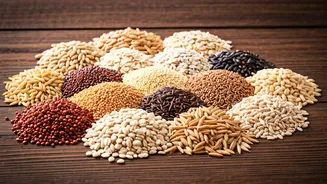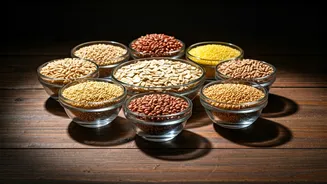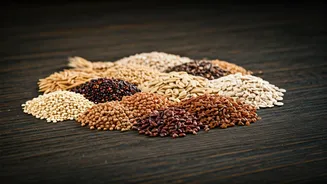Whole Grains Defined
Whole grains are an essential element of a balanced diet, distinguished by the fact that they contain all three parts of the grain kernel: the bran, germ,
and endosperm. Unlike refined grains, which have the bran and germ removed, whole grains retain their complete nutritional profile. This means they are richer in fiber, vitamins, minerals, and antioxidants, all of which contribute to numerous health benefits. The fiber content in whole grains is particularly important, as it aids in digestion, promotes a feeling of fullness, and helps regulate blood sugar levels. These grains are digested more slowly, preventing rapid spikes in blood sugar that can occur with processed carbohydrates. Including a variety of whole grains in your diet can support overall health and well-being, providing sustained energy and essential nutrients.
Oats and Blood Sugar
Oats are a highly regarded whole grain, frequently recommended for people with diabetes due to their impressive health benefits. The high soluble fiber content in oats, particularly beta-glucan, is a key reason for their positive impact on blood sugar. Beta-glucan helps to slow down the absorption of glucose from the digestive system into the bloodstream. This slow release prevents the sharp spikes in blood sugar levels that can occur after meals, making oats an excellent choice for maintaining stable glucose levels. Furthermore, oats are relatively low on the glycemic index (GI), which indicates how quickly a food raises blood sugar. Foods with a low GI value are preferred because they cause a slower and more gradual increase in blood sugar compared to foods with a high GI. Incorporating oats into your breakfast or other meals can be a simple and effective way to support healthy blood sugar control.
Quinoa's Nutritional Power
Quinoa stands out as a unique whole grain, celebrated for its complete protein profile and exceptional nutritional value. Unlike many other grains, quinoa contains all nine essential amino acids, making it a complete protein source. This characteristic is particularly valuable for vegetarians and vegans, who need to ensure they get all essential amino acids from their diet. In addition to being a complete protein, quinoa is also a good source of fiber, which helps regulate blood sugar levels. The fiber slows down the digestion and absorption of carbohydrates, preventing rapid spikes in blood sugar. Quinoa's low glycemic index (GI) further contributes to its suitability for people with diabetes. Its gradual release of glucose into the bloodstream means it won't cause the same blood sugar fluctuations as high-GI foods. Quinoa is also rich in various vitamins and minerals, adding to its overall health benefits.
Barley and Health
Barley is a nutritious whole grain with significant benefits for blood sugar management. It is particularly rich in soluble fiber, including beta-glucan, which has been shown to improve insulin sensitivity and regulate blood sugar levels. The fiber in barley slows down the digestion and absorption of carbohydrates, preventing rapid increases in blood glucose after meals. This characteristic is especially helpful for people with diabetes or those at risk of developing the condition. Barley's low glycemic index (GI) further aids in blood sugar control, contributing to its suitability for people monitoring their glucose levels. Consuming barley regularly can also contribute to improved heart health, as its fiber content helps lower cholesterol levels. Barley's versatility in cooking makes it a valuable addition to a balanced diet, whether used in soups, salads, or as a side dish.
Brown Rice Benefits
Brown rice is a staple whole grain that offers substantial advantages for blood sugar regulation. Unlike white rice, which has undergone processing that removes the bran and germ, brown rice retains these nutritious components. This means it provides a higher fiber content, contributing to its positive effects on blood sugar. Fiber slows down the digestion and absorption of carbohydrates, leading to a more gradual rise in blood glucose levels after meals. This is especially beneficial for people with diabetes or insulin resistance, as it prevents sudden spikes that can be detrimental. Brown rice also has a lower glycemic index (GI) compared to white rice. Incorporating brown rice into your diet is a simple yet effective step toward improved blood sugar control and overall health.
Buckwheat for Wellness
Buckwheat, despite its name, is not related to wheat; it's a seed that provides a unique blend of nutrients and health benefits. Buckwheat is particularly good for blood sugar management because it has a low glycemic index (GI). This means that it causes a slow and steady release of glucose into the bloodstream, which is ideal for people with diabetes. The high fiber content in buckwheat further contributes to this effect by slowing down the digestion and absorption of carbohydrates. Buckwheat also contains compounds that may improve insulin sensitivity, aiding the body in using insulin more effectively. Regular consumption of buckwheat can help keep blood sugar levels stable, reducing the risk of spikes and crashes. Buckwheat can be used in various ways, from breakfast porridge to noodles and pancakes.
Millet and Health
Millet is a group of small, round grains that are a valuable part of a healthy diet, especially for individuals aiming to regulate their blood sugar. Millet has a relatively low glycemic index (GI), indicating that it causes a slow and steady rise in blood sugar levels. This is due to its high fiber content and the way its carbohydrates are digested. Fiber slows down the digestion of food, preventing rapid spikes in blood sugar that can occur with high-GI foods. Millet is also rich in essential nutrients, including magnesium, which is important for insulin function. Including millet in your diet can help improve blood sugar control and support overall metabolic health. Millet can be cooked and eaten in various forms, making it a versatile addition to your meals.
Amaranth's Advantages
Amaranth, often used like a grain, is a highly nutritious seed that offers remarkable advantages for blood sugar management. Amaranth has a low glycemic index (GI), which means it releases glucose into the bloodstream gradually. This gradual release prevents the sharp spikes in blood sugar levels that can occur after meals, which is particularly beneficial for people with diabetes. Furthermore, amaranth is rich in fiber, both soluble and insoluble. Soluble fiber slows the absorption of glucose, while insoluble fiber helps with digestive health. Including amaranth in your diet can help keep your blood sugar levels stable. It is also a complete protein, containing all nine essential amino acids. Amaranth is adaptable and can be used in numerous dishes, from breakfast porridges to side dishes, making it a versatile addition to a health-conscious diet.
Spelt for Stable Sugar
Spelt, an ancient grain, has gained recognition for its nutritional benefits, especially its potential to help regulate blood sugar levels. Spelt contains a good amount of fiber, which is crucial for controlling how quickly your body absorbs carbohydrates. Fiber slows down digestion, ensuring that glucose enters the bloodstream slowly. This slower release helps to prevent the sharp spikes in blood sugar that are problematic for people with diabetes or insulin resistance. Additionally, spelt has a moderate glycemic index (GI) compared to some other grains. This means it has a balanced effect on blood sugar levels, helping to maintain them at a steady state. Opting for spelt as part of your diet can be a valuable strategy to improve blood sugar control and promote overall metabolic health. It can be prepared and used in meals, providing a wholesome approach to balanced eating.
Freekeh for Control
Freekeh, a grain made from young, green wheat, has garnered attention for its significant health benefits, especially its capacity to help manage blood sugar levels. Freekeh is high in fiber, a key element for anyone aiming to control blood sugar. The high fiber content slows down the digestion of carbohydrates, which in turn prevents the rapid spikes in blood sugar that typically follow meals. This means that after eating freekeh, blood sugar levels rise more gradually and stay more stable. Freekeh also has a low to moderate glycemic index (GI) compared to refined grains. This means it releases glucose into the bloodstream at a controlled pace, which is beneficial for people with diabetes or those looking to improve insulin sensitivity. Adding freekeh to your diet is a good approach to support healthy blood sugar control and overall well-being. It can be used in a variety of dishes.
